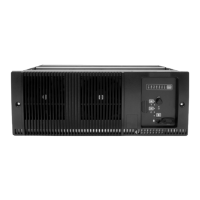TB9100 Reciter Service Manual Network Circuitry 43
© Tait Electronics Limited January 2006
The bus monitor timer monitors the duration of bus cycles to ensure that
they are terminated within a reasonable time. If the timer expires, it asserts
the TEA
signal (see “MPC Bus Cycles” on page 48) to terminate the bus
cycle with an error condition. The bus monitor time-out period is
programmable up to 2040 bus clocks ie. approximately 32.6us at a 62.5MHz
bus clock.
The software watchdog timer provides a means of terminating a runaway
program. If the watchdog is not serviced by periodically by writing specific
data patterns to its service register, it eventually times out and issues a reset
or a non-maskable interrupt (NMI). The watchdog timer has a
programmable16-bit down counter, which is clocked from a divide-by-
2048 prescaler from the main system clock. Therefore, with a 125MHz
system clock, the watchdog time-out periods can range from approximately
16us through to approximately 1s.
The periodic interrupt timer (PIT), decrementer and time base are 16, 32
and 64-bit counters respectively. They can be used to generate interrupts at
specific times and are mainly used for operating system timing functions.
Interrupts Four of the eight levels of external interrupt inputs available on the MPC
are used in the ASIF, as detailed in Tabl e 5.1. All but IRQ0
can be masked
under software control to ignore that interrupt source. The pin for IRQ7
is
utilized as a clock input for the MII (see “Media Independent Interface
(MII)” on page 76); therefore IRQ7
must be masked to avoid numerous
spurious interrupts.
All interrupt inputs are active low and can be configured to be either edge
or level sensitive. The priority of the external interrupts is fixed, ie. a higher
priority interrupt request service routine cannot be interrupted by a lower
priority interrupt request. Interrupts from internal sources are combined
and prioritized along with external interrupts (see “Interrupt Controller”
on page 55).
Table 5.1 MPC Interrupt Sources
Interrupt Input Priority Type Source
IRQ0 Highest Non-maskable not used
IRQ1
Maskable 1 PPS
IRQ2
Maskable not used
IRQ3
Maskable DSP host port
IRQ4
Maskable Ethernet PHY
IRQ5
Maskable not used
IRQ6
Maskable E-lead
IRQ7
Lowest Maskable not used

